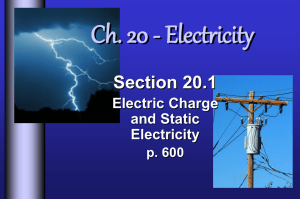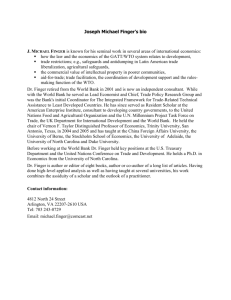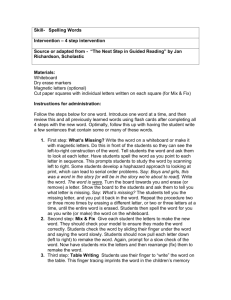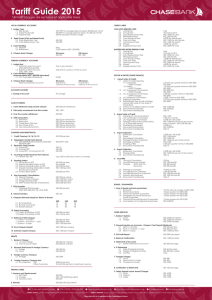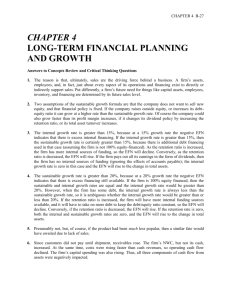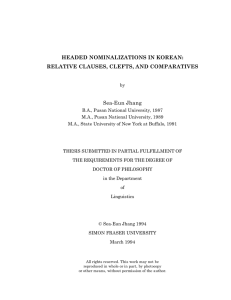solution03
advertisement
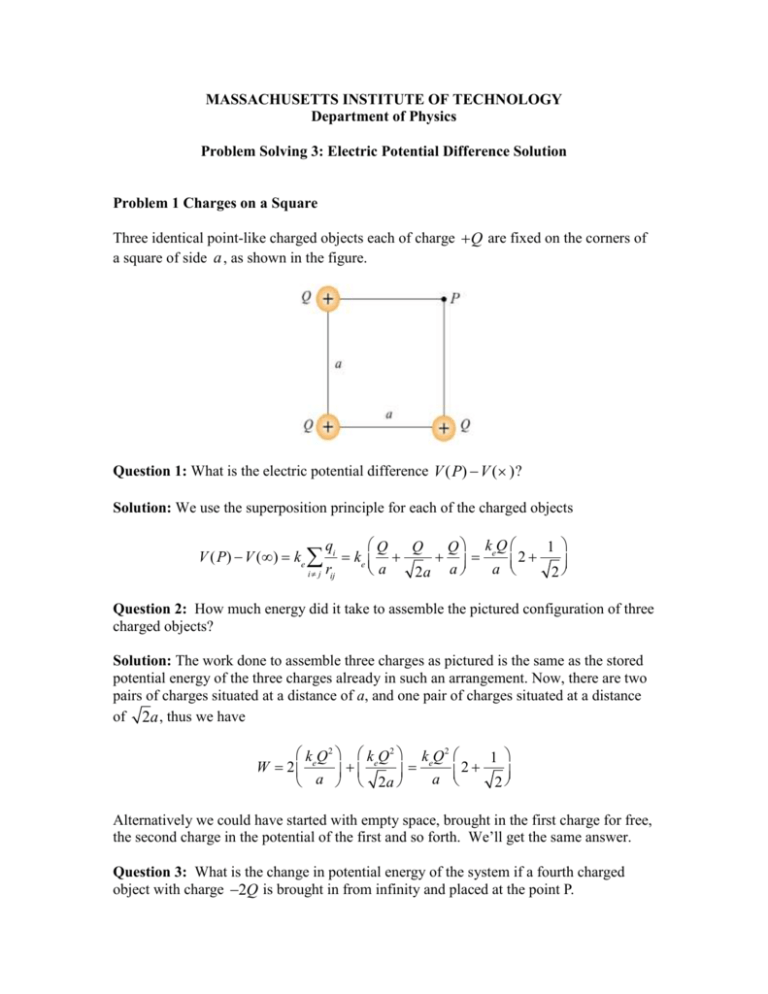
MASSACHUSETTS INSTITUTE OF TECHNOLOGY Department of Physics Problem Solving 3: Electric Potential Difference Solution Problem 1 Charges on a Square Three identical point-like charged objects each of charge +Q are fixed on the corners of a square of side a , as shown in the figure. Question 1: What is the electric potential difference V (P) - V (¥) ? Solution: We use the superposition principle for each of the charged objects æQ qi Q Qö k Q æ 1 ö = ke ç + + ÷ = e ç2+ ÷ a è èa 2a a ø 2ø i¹ j rij V (P) - V (¥) = ke å Question 2: How much energy did it take to assemble the pictured configuration of three charged objects? Solution: The work done to assemble three charges as pictured is the same as the stored potential energy of the three charges already in such an arrangement. Now, there are two pairs of charges situated at a distance of a, and one pair of charges situated at a distance of 2a , thus we have æ k Q2 ö æ k Q2 ö k Q2 æ 1 ö W = 2ç e ÷ + ç e ÷ = e ç 2 + ÷ a è è a ø è 2a ø 2ø Alternatively we could have started with empty space, brought in the first charge for free, the second charge in the potential of the first and so forth. We’ll get the same answer. Question 3: What is the change in potential energy of the system if a fourth charged object with charge -2Q is brought in from infinity and placed at the point P. Solution: The change in potential energy of the system DU = -2Q(V (P) - V (¥)) = - 2keQ 2 æ 1 ö 2+ ç ÷ a è 2ø Problem 2: Consider a positively charge annulus of inner radius a and outer radius b lying in the xy -plane and centered on the origin with uniform positive surface charge density s . Question 1: Let V (¥) = 0 . Calculate the electric potential V (z) at a point P lying on the positive z -axis, a distance z from the origin. You may find the following integral useful r ¢ =b ò r ¢ =a r ¢dr ¢ r ¢2 + z 2 = r ¢2 + z 2 r ¢ =b r ¢ =a . Solution: The potential difference V (P) - V (¥) between infinity and the point P lying on the positive z -axis, a distance z from the origin is given by the expression V (P) - V (¥) = ks da¢ ò source r - r ¢ Choose as an integration element a small area of radius r ¢ , arc length r ¢dq ¢ , and width dr ¢ with charge dq¢ = s da¢ where da¢ = r ¢dq ¢dr ¢ . The vector form the origin to the field point P is r = z k̂ and the vector from the origin to the any point on the ring is r¢ = r ¢r̂ . Therefore in the above expression r - r¢ = z k̂ - r ¢r̂ is the vector from the integration element to the field point P and the distance is r - r¢ = r ¢ 2 + z 2 . So the integral becomes V (P) - V (¥) = ò source kes da¢ r - r¢ = kes r¢=b ò r ¢= a q ¢ = 2p r ¢dr ¢ r¢2 + z 2 ò dq ¢ = 2p kes q ¢ =0 r¢=b ò r¢= a r ¢dr ¢ r¢2 + z 2 Integration is straightforward: V (P) = kes r ¢ =b ò r ¢ =a r ¢dr ¢ r¢ + z 2 = 2p kes r ¢ + z 2 2 2 r ¢ =b r ¢ =a = 2p kes ( b2 + z 2 - a 2 + z 2 ) Question 2: Suppose a negatively charged object with charge -q and mass m is at the point P located at r = z k̂ . The particle is released from rest. What is its kinetic energy when it reaches the point z = 0 ? Solution: Because there are no non-conservative force, energy is constant and therefore DU + DK = 0 . The change in potential energy is DU = -qDV = -q(V (0) -V (P)) ( = -q2p kes (b - a) - ( b2 + z 2 - a 2 + z 2 )) . Because the charged object was released from rest, the change in kinetic energy is DK = K(0) - K(P) = K(0) . So the fact that energy is constant implies that DK = -DU . Hence ( K(0) = -DU = q2p kes (b - a) - ( )) b2 + z 2 - a 2 + z 2 . Problem 3: Shocking… It’s winter at MIT and after scuffing across the carpet in your dorm room you reach for the doorknob with your index finger extended and get a tremendous shock. We shall try to estimate how many excess electrons were on your finger just before you received the shock and what was the potential difference between you and the doorknob? We will just make an approximate calculation so you will need to make a series of simplifying assumptions. Question 1: Assume your finger has a charge Q distributed over its surface. Model your finger as a conducting sphere. What would be a reasonable estimate for the radius of that sphere? Answer: 1 cm . Question 2: What is an approximate expression for the electric field at the surface of your finger? Answer: E kQ / r 2 Question 3: How many excess electrons were on your finger just before you received the shock? (HINT: Dry air breaks down at an electric field strength of about 3 ´ 10 6 V/m .) Answer: Question 4: What does the doorknob do? Answer: It attracts the excess charge in your body, essentially pulling it into your finger. Question 5: Estimate how far away your finger is from the doorknob when you get a shock? Answer: The tip of your finger is about a mm away from the doorknob when we get a shock. Question 6: Estimate the potential difference between you and the doorknob? Answer: DV Ed = (3 ´ 106 V/m)(1 mm) = 3000 V Alternatively, we could have said it was a planar conductor of area ~ 1 cm2, then:

